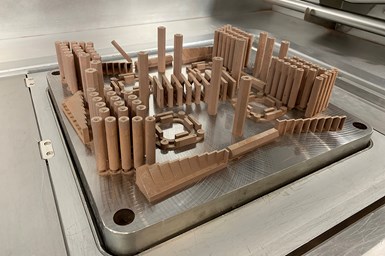Sintavia Develops Proprietary Copper Printing Technology
The printing technology is designed for use with GRCop-42, the preferred copper alloy used by NASA and private space flight companies for rocket thrust chamber assemblies
Share
Read Next

Sintavia’s technology unlocks the potential of printing GRCop-42 both cost-effectively and with excellent mechanical properties.
Sintavia has developed proprietary printing technology for GRCop-42, the preferred copper alloy used by NASA and private space flight companies for rocket thrust chamber assemblies. The technology is a combination of a proprietary parameter set and postprocessing heat treatment that could enable a new generation of flight and launch components.
The technology was developed on an EOS GmbH M400-4 printer, and results in GRCop-42 components with a minimum density of 99.94%, minimum tensile strength of 28.3 ksi, minimum ultimate yield strength of 52.7 ksi, and minimum elongation of 32.4%. Importantly, the technology avoids the use of a hot isostatic press in postprocessing steps, thereby reducing the time, complexity and cost of production, the company says.
This technology is said to unlock the potential of printing GRCop-42 both cost-effectively and with excellent mechanical properties. According to the company, GRCop-42 has been a difficult metal for additive manufacturing and this new material parameter and furnacing specification should enable full alloy adoption for AM applications within the aerospace, defense and space industry.
Sintavia is also currently developing proprietary standards for other materials, including refractory alloys, for use across the aerospace, defense and space industry.
Related Content
-
8 Transformations 3D Printing Is Making Possible
Additive manufacturing changes every space it touches; progress can be tracked by looking for moments of transformation. Here are 8 places where 3D printing is enabling transformative change.
-
Will the Successes of NASA’s RAMFIRE Project Lead to an Operational Aerospike Engine?
NASA’s RAMFIRE project has additively manufactured a 36-inch diameter aerospike nozzle with complex integral coolant channels for a more efficient way to propel rockets to outer space. NASA engineers will use this as a proof of concept to inform future component designs.
-
3D Printed NASA Thrust Chamber Assembly Combines Two Metal Processes: The Cool Parts Show #71
Laser powder bed fusion and directed energy deposition combine for an integrated multimetal rocket propulsion system that will save cost and time for NASA. The Cool Parts Show visits NASA’s Marshall Space Flight Center.










